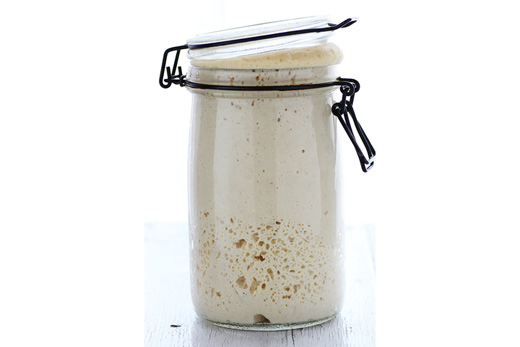FTC Disclosure: Delicious Obsessions may receive comissions from purchases made through links in this article. As an Amazon Associate I earn from qualifying purchases.Read our full terms and conditions here.
I am so excited to welcome Kresha, author of the Nourishing Joy website, to Delicious Obsessions! Today, Kresha is sharing her love of sourdough with all of us! I am very excited about this post because I have never really branched out into bread baking, other than pumpkin bread, muffins, etc. I love sourdough bread, and honestly, it is the only bread that I eat. However, when it comes to actually baking a loaf of bread, I am very intimidated. It is because of this that I was thrilled when Kresha told me what she would like to share. She shows us just how easy it is to make delicious, sourdough bread. Please give her a warm welcome to Delicious Obsessions and when you’re done here, head over to Nourishing Joy and check out all the great material she has on her site! If you’re in need of a sourdough starter and you don’t have anyone local that will share with you, Cultures for Health has a lovely variety of starters on their site. ~Jessica
Sourdough: The Bad-A** Baker’s Secret
Guest Post from Kresha of Nourishing Joy
Sourdough is a love in my life.
Ferment, in general, excite me, with all their bad-a** bacteria turning simple ingredients into something greater, but sourdough is what I tend most lovingly. There is deep satisfaction in watching the starter bubble and grow and when baked as bread, the unique tangy, earthy scent transports me to bakeries in far-away places where I traveled when I was younger.
And perhaps it’s sourdough’s unique versatility that captures me as well. In my kitchen, sourdough is used not only for yeast breads, but for quick breads, pancakes, cookies, cakes, crackers, muffins, doughnuts, pasta, cinnamon rolls, dinner rolls, pizza crust, pie crust, waffles, and gingerbread, just to name a few. (Don’t believe me? Check out our family’s favorite special-occasion Sourdough Black Forest Cake – that is, in my not-so-humble opinion, to die for.)
Sourdough is also a bit unusual in the fermenting world. The question I get asked most often about sourdough is, “Since the bacteria are killed when sourdough gets baked and you’re not getting the benefit of all those living enzymes and bacteria, why is sourdough good for you?”
And this is where it gets fun, as the science of sourdough is rather fascinating (and really, rather simple).
Sourdough is a lactic acid ferment like many other traditional ferments. And up until the point of baking, the lactic acid bacteria do their lovely lactic acid duty: they pre-digest gluten, they break down phytic acid and other anti-nutrients, and work to keep any “bad” bacterias at bay. This allows the yeast to proliferate and give off carbon dioxide (aka “bubbles”) as they munch their way through the starchy sugars found in the flour, which is what gives bread its beautiful rise and chewy crumb.
Then, as the sourdough is baked, it is true that most of the bacteria are killed in the process, but the important work has already been done. The flour is partially digested, making it easier on your digestive system. The anti-nutrients have been neutralized, so the iron, zinc, and other essential minerals found in the grain are now bio-available to you. And the wild yeasts have leavened the dough – be it a yeast bread or a chocolate cake – so there is a delightful crumb in whatever you choose to bake.
So, in celebration of sourdough, here is one of my favorite sourdough recipes, the simple and scrumptious Rustic Rosemary Sourdough Foccacia. If you’d like something a bit more non-traditional, check out our Dark Chocolate Sourdough Cupcakes with Pretty Pink Buttercream (my 6-year-old daughter’s choice for her recent birthday party).
Rustic Rosemary Sourdough Foccacia
These instructions are for an electric mixer because with several little ones underfoot, I find it’s the only way to get my bread baked. However, if you prefer to mix the dough by hand, by all means do so – you’ll have a better sense of the dough too!
For the dough:
1 1/2 cups sourdough starter, active and bubbly
1 cup warm water
1/2 cup extra virgin olive oil
1 tablespoon honey
2 teaspoons fine sea salt
4-5 cups your choice of flour
For sprinkling:
2-3 tablespoons extra virgin olive oil
5 sprigs of fresh rosemary, trimmed and leaves chopped
1 tablespoon coarse sea salt
Instructions:
1. In the mixing bowl of an electric mixer fitted with the paddle attachment, mix the starter, water, oil, honey, and salt until well-combined. Switch to the dough hook and with the motor running, add the flour 1/2 cup at a time
2. Knead the mixture for 5-6 minutes on slow until the mixture is soft, slightly moist, but no longer sticky. Add more flour if you need to, as different sourdoughs and different flours will vary in their hydration rates, but be very judicious – too much flour will render the final focaccia tough and dense.
3. Form dough into a ball and place in a large, lightly oiled bowl. Cover with plastic wrap and let sit at room temperature for 3-4 hours.
4. Punch the dough down and let it rise again until it’s doubled in bulk, about 1 hour.
5. Meanwhile, oil a large, rimmed baking sheet with olive oil, spreading it over the entire pan with your fingers, and preheat the oven to 425 degrees Fahrenheit. Place the entire round of dough on the sheet and press it down until it’s about 1-inch thick or it covers the entire baking sheet. (If your dough is very elastic and won’t let you stretch it, allow it to rest for 5-10 minutes.) Lightly, make small indentations all over the dough, then pour on the olive oil, making sure it ends up in some of the dimples. Sprinkle the chopped rosemary and coarse sea salt, let sit for 15-20 minutes, then bake for 20-25 minutes or until golden brown and the interior temperature is 190 degrees Fahrenheit.
6. Allow to cool on the pan for 5-10 minutes, then move to a cooling rack. Serve warm or at room temperature.
 Kresha Faber is the chief writer and blog editor at NourishingJoy.com, a website dedicated to real food, sustainable living, natural homemaking, and joyful parenting. She is the mother of three young children, the wife of an incredibly good man, an opera singer, a cloth diapering instructor, and an avid researcher. She and her husband share a passion for living life thoughtfully and intentionally in response to God’s grace in their lives and she loves to share good meals around a very large table. You can learn more about Kresha on her website, or catch up with her on Facebook or Pinterest.
Kresha Faber is the chief writer and blog editor at NourishingJoy.com, a website dedicated to real food, sustainable living, natural homemaking, and joyful parenting. She is the mother of three young children, the wife of an incredibly good man, an opera singer, a cloth diapering instructor, and an avid researcher. She and her husband share a passion for living life thoughtfully and intentionally in response to God’s grace in their lives and she loves to share good meals around a very large table. You can learn more about Kresha on her website, or catch up with her on Facebook or Pinterest.


8 Comments